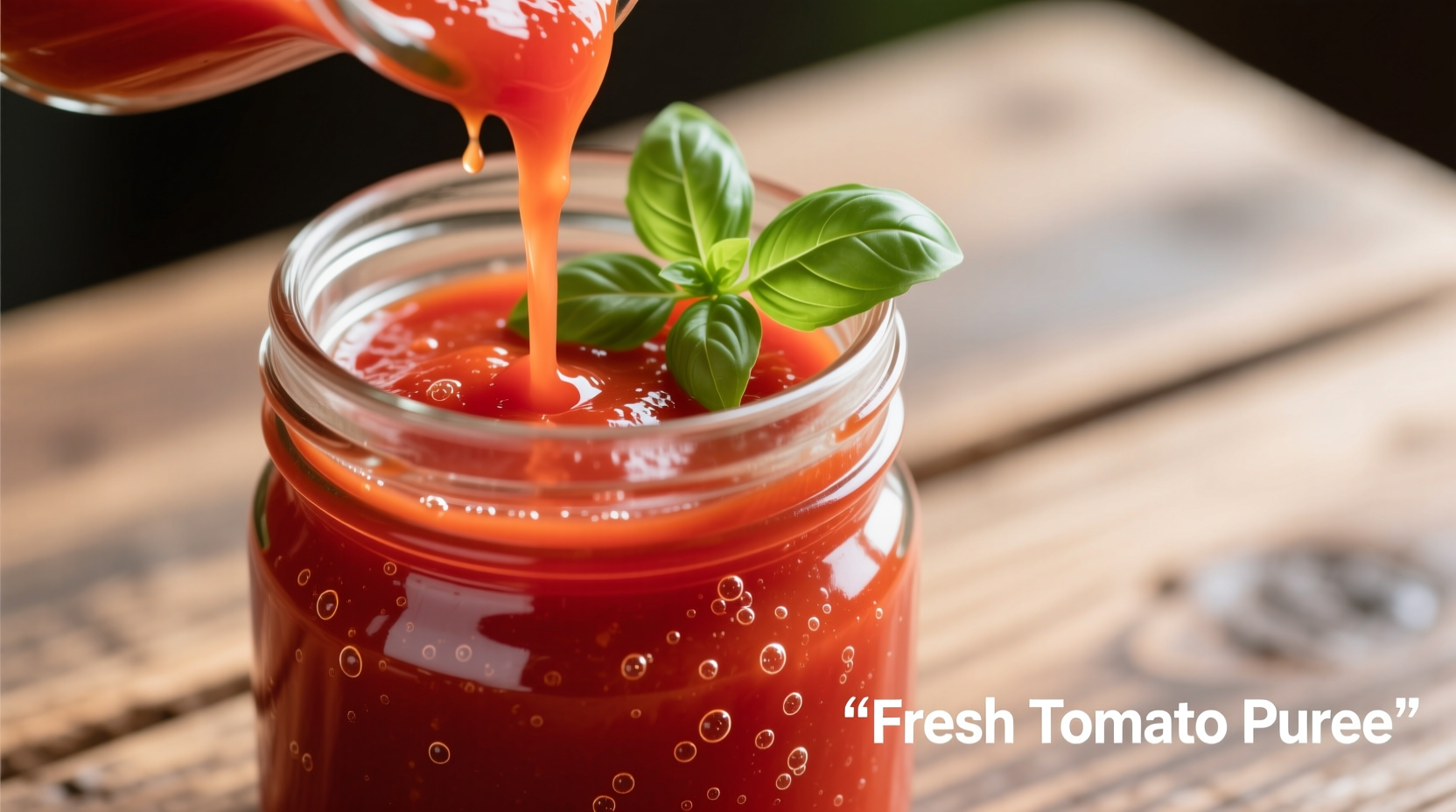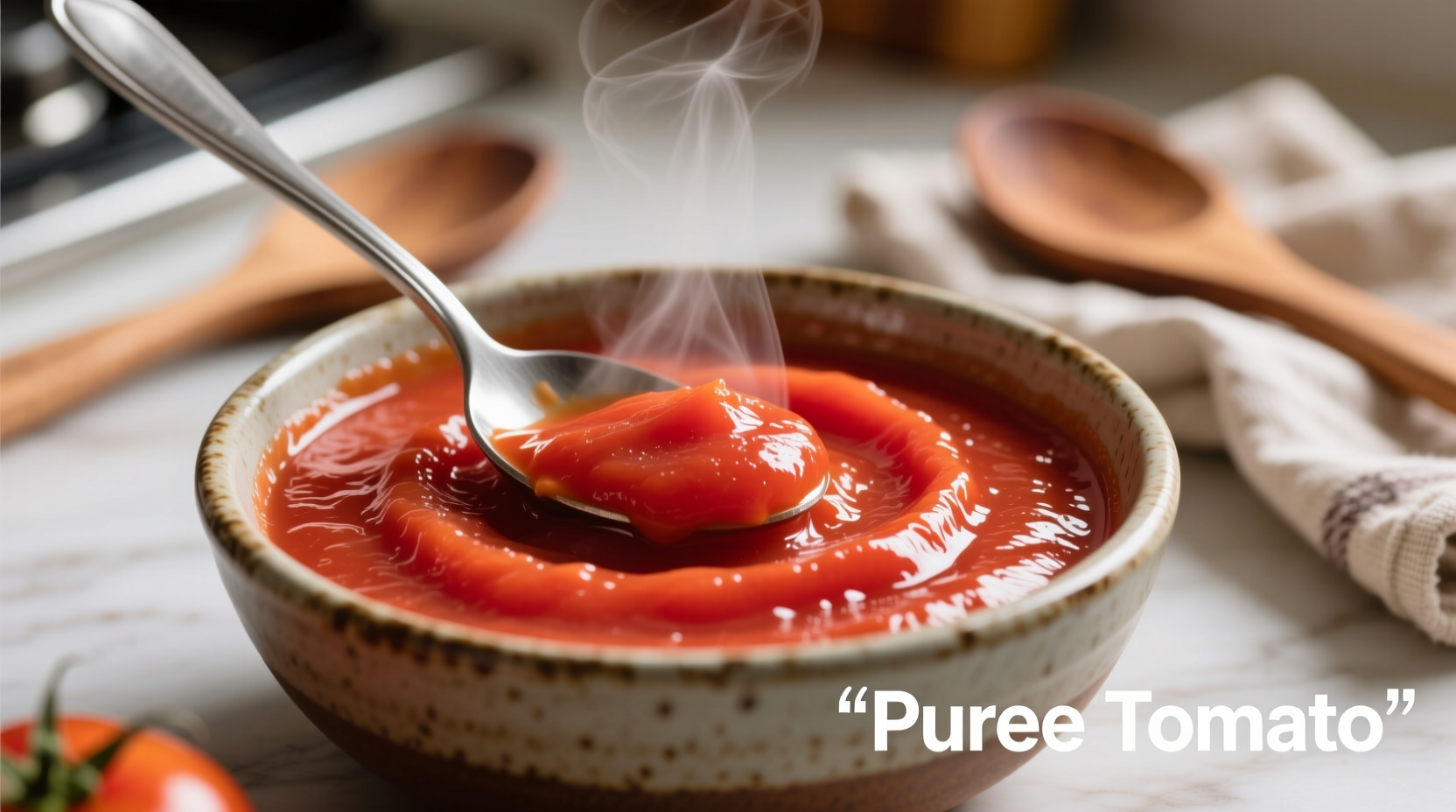What Exactly Is Tomato Puree and Why It Matters in Cooking
Tomato puree represents one of cooking's most versatile foundations—a smooth, cooked tomato liquid with a consistency thicker than sauce but thinner than paste. Unlike raw tomato sauce, proper puree undergoes controlled cooking that concentrates flavor while preserving natural sweetness and acidity balance. Professional chefs rely on quality puree as the flavor backbone for Italian ragùs, Spanish sofritos, and Indian curries.
According to the USDA FoodData Central, 100g of tomato puree contains 44 calories, 2.2g fiber, and delivers 22% of your daily vitamin C needs. The cooking process actually increases lycopene bioavailability by up to 35% compared to raw tomatoes, making puree a nutritionally superior choice for regular consumption.
| Tomato Product | Texture | Solids Content | Best Culinary Uses |
|---|---|---|---|
| Tomato Puree | Smooth, pourable liquid | 8-12% solids | Soups, stews, braises |
| Tomato Paste | Thick, concentrated | 24-30% solids | Flavor base, color enhancement |
| Tomato Sauce | Thin, often seasoned | 5-8% solids | Pasta dishes, quick sauces |
| Crushed Tomatoes | Chunky texture | 8-11% solids | Marinara, pizza sauce |
Creating Perfect Homemade Tomato Puree: Step-by-Step
While store-bought options exist, homemade puree offers superior flavor control and avoids unnecessary additives. The National Center for Home Food Preservation confirms that proper technique ensures safe, shelf-stable results when following tested methods.
Essential Equipment Checklist
- Food mill or fine-mesh strainer (critical for seed/skin removal)
- Heavy-bottomed stainless steel pot (prevents scorching)
- Immersion blender (for initial texture control)
- Acid-resistant containers for storage
Tomato Selection: The Flavor Foundation
University agricultural extensions consistently recommend Roma (plum) tomatoes for puree production due to their lower water content and higher flesh-to-seed ratio. As noted by Cornell University's Food Venture Center, "Romas contain approximately 5.5% solids compared to 3.8% in standard slicing tomatoes, yielding 30% more concentrated product with less cooking time."
Two Proven Methods for Different Results
Raw Puree Method (Bright, Fresh Flavor)
- Blanch tomatoes in boiling water for 30 seconds, then ice bath
- Peel skins and roughly chop tomatoes
- Pulse in food processor until smooth (do not over-process)
- Strain through food mill to remove seeds and remaining skin
- Store immediately or process for shelf stability
Ideal for fresh sauces where bright tomato flavor is essential. Best used within 3 days refrigerated.
Cooked Puree Method (Rich, Concentrated Flavor)
- Simmer chopped tomatoes with 1 tbsp lemon juice per quart (for pH safety)
- Maintain gentle simmer for 25-35 minutes, stirring occasionally
- Pass through food mill while still hot
- Return to heat and reduce to desired thickness (typically 20-30 minutes)
- Test consistency: should coat the back of a spoon
This method develops deeper flavor through controlled caramelization while meeting USDA safety standards for home canning.

Practical Applications: Using Puree Like a Professional
Understanding when and how to use puree transforms ordinary dishes. Unlike paste which requires "blooming" in fat, puree integrates seamlessly into liquid-based dishes while providing body without excessive thickness.
Flavor Development Techniques
- For soups and stews: Add puree during the last 30 minutes of cooking to preserve fresh flavor
- For sauces: Simmer puree with aromatics (onion, garlic) for 10-15 minutes before adding other liquids
- For pizza: Use uncooked puree mixed with a pinch of oregano and garlic powder as base
Common Mistakes to Avoid
- Over-reducing puree (creates bitter, caramelized flavor)
- Using poor-quality store brands with added thickeners
- Adding puree too early in long-cooked dishes (flavor becomes flat)
Storage Methods That Preserve Freshness and Safety
Proper storage ensures your puree maintains quality and safety. The National Center for Home Food Preservation provides verified timelines:
| Storage Method | Refrigeration | Freezer | Canned |
|---|---|---|---|
| Unprocessed Puree | 3-4 days | Not recommended | N/A |
| Processed Puree (with acid) | 5-7 days | 10-12 months | 18-24 months |
| Signs of Spoilage | Bubbles, mold, sour smell | Freezer burn, color change | Bulging lid, off-odor |
Freezing for Maximum Flavor Retention
Freeze puree in ice cube trays first, then transfer to labeled freezer bags. This portion-controlled method lets you use exactly what you need. For best results, leave ½ inch headspace in containers and remove as much air as possible from bags.
Canning Safety Essentials
When canning tomato puree, always add acid (1 tbsp bottled lemon juice or ¼ tsp citric acid per pint) to ensure safe pH levels below 4.6. Process pints for 35 minutes in a boiling water bath at sea level (adjust for altitude). The FDA confirms this method prevents botulism risk in home-canned tomato products.











 浙公网安备
33010002000092号
浙公网安备
33010002000092号 浙B2-20120091-4
浙B2-20120091-4